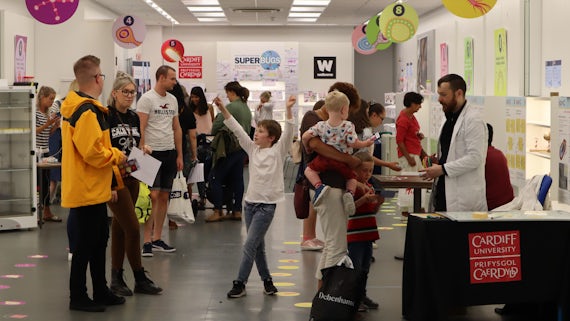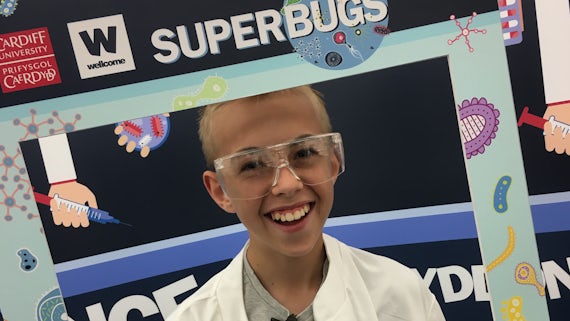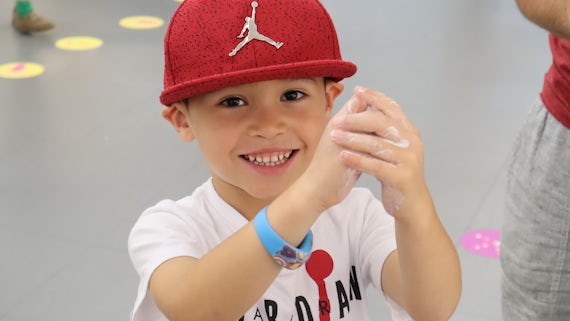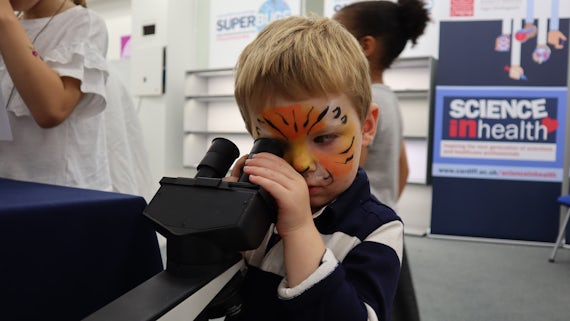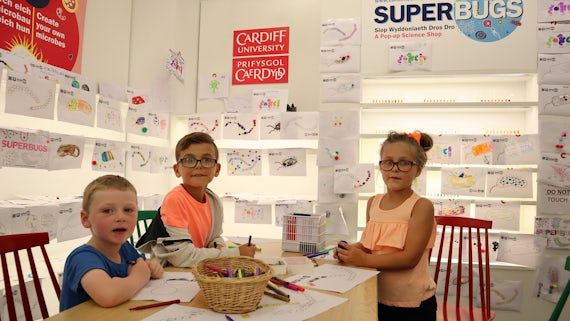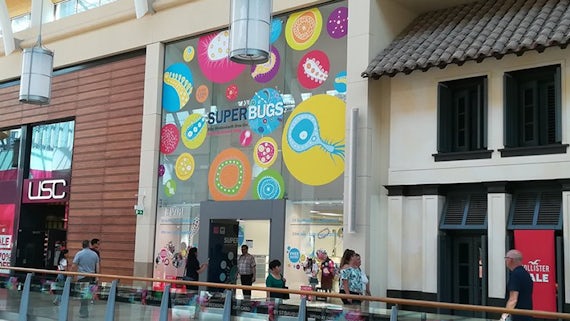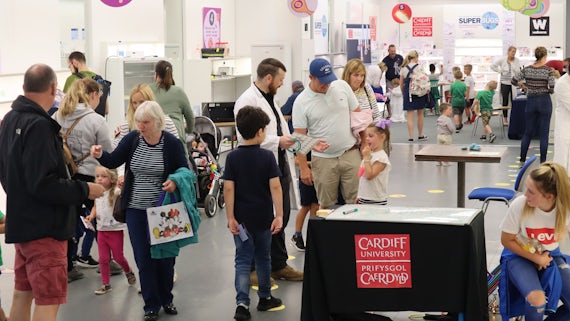Superbugs - a pop-up science event
'Superbugs' was an ISSF3 Public Engagement Proof-of-Concept grant funded project which intended to increase public awareness of the microbial world in, on and around us, and the threat of antibiotic resistance, through an innovative delivery model.
Video looking back at the Superbugs event.
We converted a vacant retail unit in the heart of Wales’s busiest shopping centre, St David's Dewi Sant (SD2) into an interactive and professionally designed microbiology ‘laboratory’ experience. By accessing natural footfall (approximately 700,000 visitors/week), we managed to take ‘science to the city’, with access for all public demographics.
Between 29 July - 11 August 2019, 6,566 visitors engaged with research scientists and immersive microscopy workshops, ‘fun-fayre’ games demonstrating the evolution of antibiotic resistance, and the chance to swab themselves and ‘grow their own microbes’.
A sticker-challenge created 1626 ‘Antibiotic Resistance Champions’ to spread the message across 200 schools throughout Wales, and more beyond.
Explore the activity stations
Visitors were welcomed to Superbugs and given their sticker collection card. They were then faced with three basic questions around antibiotics, stewardship, and resistance. Visitors were asked to answer by placing a pipette tip into the relevant jar, and then asked to repeat the exercise at the exit.
Information boards were on display introducing visitors to the bacterial world. This included cuddly toy bacteria (courtesy of GiantMicrobes) for the visitors to interact with.
This was an information station showing just how widespread bacteria are. This was displayed using colourful agar plates with bacterial grown from a host of household locations and different body parts.
This station included a handwashing game to show how easy it is to miss dirt and germs, and then the chance for visitors to swab parts of their body and inoculate onto an agar plate. We then took these plates to our laboratory at Cardiff University, grew up the bacteria, and posted photos anonymously on Facebook for visitors to view at a later date by using their unique code. By the end of the event we had uploaded over 2100 photos of visitor swab plates.
This was an arts and crafts corner. At the culmination of the event we had nearly 400 artworks decorating the walls of the Superbugs shop, a selection of which were also posted on social media. We are also in early discussions about the possibility of an artwork display to showcase some of the material produced for, and by, ‘Superbugs’.
Here we enabled visitors to get hands on with microscopes, and up close and personal to a number of different bacteria of different shapes and sizes.
Information boards provided the timelines of significant infections through history, and introduced visitors to the concept of antibiotics, what they are, and how they work.
A fun coconut-shy game, to teach visitors the difference between ‘susceptible bacteria’ (those that could be knocked down with the ‘antibiotic beanbag’) and those that were resistant (those that could not be knocked down).
Another fun station which introduced the concept of bacteria ‘sharing’ DNA, and involved the visitors taking part in a ‘plasmid’ ring toss, trying to pass their DNA onto our giant bacteria model.
A large bacterial thought tree was created by our visitors who were encouraged to leave their thoughts and comments on what they had learnt, or on the event itself.
The final station aimed to teach visitors about the lengths now being taken to combat resistance and discover new antibiotics. This involved an ‘Antibiotic discovery ball pit’ where visitors were blindfolded and encouraged to hunt for the ‘new antibiotics’.
Contact us
For further information about Superbugs, please email us, visit our educational resource and/or follow @CUSuperbugs on Twitter.
Medic Engagement
Superbugs team
Core team
Science team
- Jordan Matthias
- Katy Thomas
Volunteers
- Raya Ahmed
- Abdullah Almusallam
- Sarah Baker
- Rebecca Bayliss
- Marie-Claire Bell
- Ian Boostrom
- Simone Cuff
- Karen Edwards
- Refath Farzana
- Ana Ferreira
- Hyun-Sun Jin
- Giulia Lai
- Mei Ling
- Mark Ponsford
- Savitha Radhakrishan
- Mike Roberts
- Kirsty Sands
- Louise Stack
- Mark Toleman
- Lucas Tselepis
- Tim Walsh
- Janis Weeks
- Emma Widlake
- Qiu Yang
A new bilingual website has been created to educate and enthral children.
